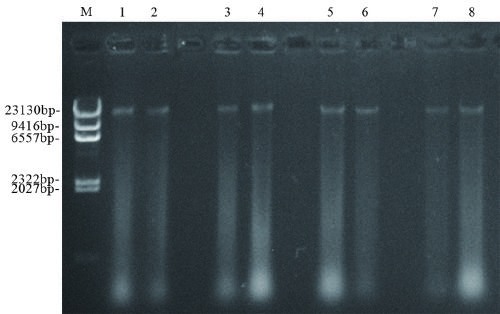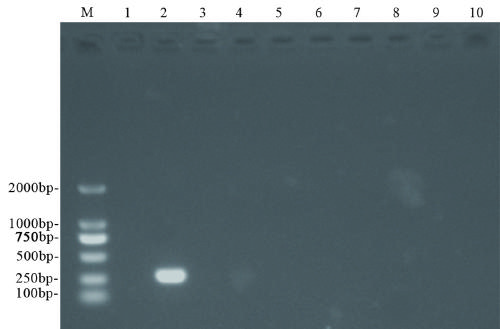Identification method for existence of fungus in ganoderma lucidum tissue and assessment method for necessity of fungus for formation of ganoderma lucidum
An identification method, Taisui technology, applied in the direction of biochemical equipment and methods, microbial determination/inspection, etc., can solve the problem of not being able to obtain all the genetic information of various types of bacteria, avoid the interference of polysaccharides, and simplify the operation. Effect
- Summary
- Abstract
- Description
- Claims
- Application Information
AI Technical Summary
Problems solved by technology
Method used
Image
Examples
Embodiment 1
[0051] Example 1 Determination of Tai Sui Tissue Melting Temperature
[0052] 1. Determination of melting temperature
[0053] The test tube water bath method is used for determination. The test tube is used to hold Tai Sui tissue pieces and water, and the water bath provides the melting heat source.
[0054] The size of the test tube was 18*18 mm, and the volume of water was set at 10 mL to match the capacity of the disposable syringe filter in the subsequent step. After filling this amount of water, the water level will account for 1 / 3 of the length of the test tube.
[0055] The water bath is an electric heating automatic temperature control type, the temperature control accuracy is 0.5°C, and its water level should be slightly higher than the water level of the test tube.
[0056] Taisui tissue is cut into squares with a side length of 3-5 mm, and the weight of each tube is 0.4 g (wet weight, the same below).
[0057] According to observation, the Tai Sui is solid at na...
Embodiment 2
[0064] Example 2, Extraction of Fungi Information in Tai Sui Tissue
[0065] 1. Preparation of Tai Sui tissue solution
[0066] Weigh 0.6 g of Tai Sui's internal tissue, cut into pieces or debris with a side length of about 1.5 mm, and put it into a test tube with 10 mL of sterile distilled water. Under the dissolution temperature measured in Example 1, that is, in a water bath at 85°C, the test tube was shaken before and after bathing, and it could completely dissolve into a light red viscous solution in about 6 minutes.
[0067] 2. Filter out the polysaccharide in the solution
[0068] Immediately pour the dissolved Tai Sui solution into a 10 mL syringe with a 0.22 µm disposable syringe filter, and press to filter. Reserve the filtrate in a 10 mL sterile centrifuge tube.
[0069] After filtering, pull out the piston rod of the syringe, add sterile water preheated to the melting temperature, and then push the water through the membrane.
[0070] 3. Extraction of 4 major b...
Embodiment 3
[0087] Example 3 Identification and inspection of 5 major fungioids
[0088] 1. Selection and treatment of positive control bacteria
[0089] The known bacteria of bacteria, archaea, fungi, myxomycetes and mycoplasma were selected as the respective positive control bacteria for the identification of the five major fungi, wherein the positive control bacteria for the identification of mycoplasma were Mycoplasma hyorhinois ( M. Hyorhinis ); Pseudomonas was selected as the positive control bacteria for bacterial identification ( Pseudomonas sp. ); the positive control bacteria for the identification of archaea were selected from the inner lake archaea of the salt field ( H. salinus MCCC 4K00021); Fusarium was selected as the positive control bacteria for fungal identification ( Fusarium sp. ); the positive control bacteria for the identification of slime molds were Calderma sp. ( Didymium sp. ).
[0090] Put ≥ 0.1 g of wet bacteria of each positive control bacteria (10...
PUM
 Login to View More
Login to View More Abstract
Description
Claims
Application Information
 Login to View More
Login to View More - R&D Engineer
- R&D Manager
- IP Professional
- Industry Leading Data Capabilities
- Powerful AI technology
- Patent DNA Extraction
Browse by: Latest US Patents, China's latest patents, Technical Efficacy Thesaurus, Application Domain, Technology Topic, Popular Technical Reports.
© 2024 PatSnap. All rights reserved.Legal|Privacy policy|Modern Slavery Act Transparency Statement|Sitemap|About US| Contact US: help@patsnap.com










